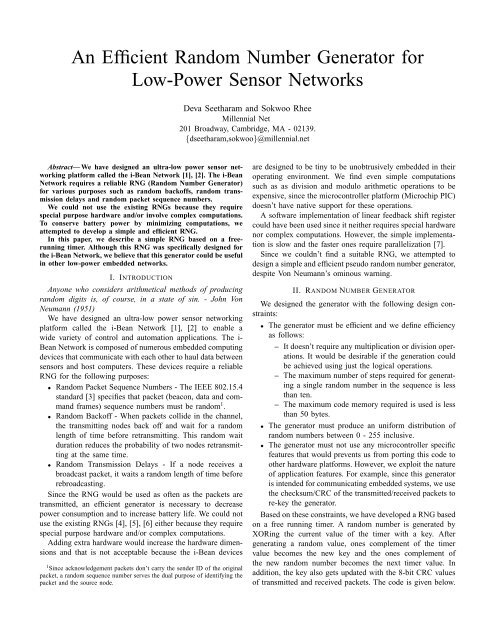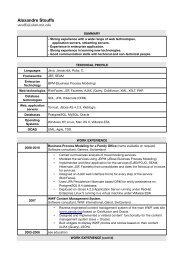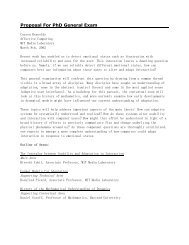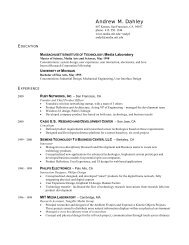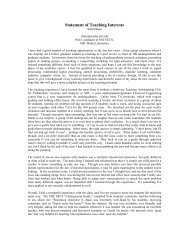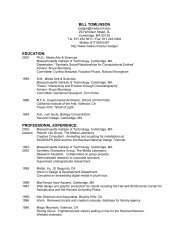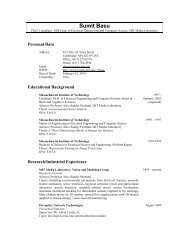An Efficient Random Number Generator for Low-Power Sensor ...
An Efficient Random Number Generator for Low-Power Sensor ...
An Efficient Random Number Generator for Low-Power Sensor ...
Create successful ePaper yourself
Turn your PDF publications into a flip-book with our unique Google optimized e-Paper software.
<strong>An</strong> <strong>Efficient</strong> <strong>Random</strong> <strong>Number</strong> <strong>Generator</strong> <strong>for</strong><br />
<strong>Low</strong>-<strong>Power</strong> <strong>Sensor</strong> Networks<br />
Abstract— We have designed an ultra-low power sensor networking<br />
plat<strong>for</strong>m called the i-Bean Network [1], [2]. The i-Bean<br />
Network requires a reliable RNG (<strong>Random</strong> <strong>Number</strong> <strong>Generator</strong>)<br />
<strong>for</strong> various purposes such as random backoffs, random transmission<br />
delays and random packet sequence numbers.<br />
We could not use the existing RNGs because they require<br />
special purpose hardware and/or involve complex computations.<br />
To conserve battery power by minimizing computations, we<br />
attempted to develop a simple and efficient RNG.<br />
In this paper, we describe a simple RNG based on a freerunning<br />
timer. Although this RNG was specifically designed <strong>for</strong><br />
the i-Bean Network, we believe that this generator could be useful<br />
in other low-power embedded networks.<br />
I. INTRODUCTION<br />
<strong>An</strong>yone who considers arithmetical methods of producing<br />
random digits is, of course, in a state of sin. - John Von<br />
Neumann (1951)<br />
We have designed an ultra-low power sensor networking<br />
plat<strong>for</strong>m called the i-Bean Network [1], [2] to enable a<br />
wide variety of control and automation applications. The i-<br />
Bean Network is composed of numerous embedded computing<br />
devices that communicate with each other to haul data between<br />
sensors and host computers. These devices require a reliable<br />
RNG <strong>for</strong> the following purposes:<br />
• <strong>Random</strong> Packet Sequence <strong>Number</strong>s - The IEEE 802.15.4<br />
standard [3] specifies that packet (beacon, data and command<br />
frames) sequence numbers must be random 1 .<br />
• <strong>Random</strong> Backoff - When packets collide in the channel,<br />
the transmitting nodes back off and wait <strong>for</strong> a random<br />
length of time be<strong>for</strong>e retransmitting. This random wait<br />
duration reduces the probability of two nodes retransmitting<br />
at the same time.<br />
• <strong>Random</strong> Transmission Delays - If a node receives a<br />
broadcast packet, it waits a random length of time be<strong>for</strong>e<br />
rebroadcasting.<br />
Since the RNG would be used as often as the packets are<br />
transmitted, an efficient generator is necessary to decrease<br />
power consumption and to increase battery life. We could not<br />
use the existing RNGs [4], [5], [6] either because they require<br />
special purpose hardware and/or complex computations.<br />
Adding extra hardware would increase the hardware dimensions<br />
and that is not acceptable because the i-Bean devices<br />
1 Since acknowledgement packets don’t carry the sender ID of the original<br />
packet, a random sequence number serves the dual purpose of identifying the<br />
packet and the source node.<br />
Deva Seetharam and Sokwoo Rhee<br />
Millennial Net<br />
201 Broadway, Cambridge, MA - 02139.<br />
{dseetharam,sokwoo}@millennial.net<br />
are designed to be tiny to be unobtrusively embedded in their<br />
operating environment. We find even simple computations<br />
such as as division and modulo arithmetic operations to be<br />
expensive, since the microcontroller plat<strong>for</strong>m (Microchip PIC)<br />
doesn’t have native support <strong>for</strong> these operations.<br />
A software implementation of linear feedback shift register<br />
could have been used since it neither requires special hardware<br />
nor complex computations. However, the simple implementation<br />
is slow and the faster ones require parallelization [7].<br />
Since we couldn’t find a suitable RNG, we attempted to<br />
design a simple and efficient pseudo random number generator,<br />
despite Von Neumann’s ominous warning.<br />
II. RANDOM NUMBER GENERATOR<br />
We designed the generator with the following design constraints:<br />
• The generator must be efficient and we define efficiency<br />
as follows:<br />
– It doesn’t require any multiplication or division operations.<br />
It would be desirable if the generation could<br />
be achieved using just the logical operations.<br />
– The maximum number of steps required <strong>for</strong> generating<br />
a single random number in the sequence is less<br />
than ten.<br />
– The maximum code memory required is used is less<br />
than 50 bytes.<br />
• The generator must produce an uni<strong>for</strong>m distribution of<br />
random numbers between 0 - 255 inclusive.<br />
• The generator must not use any microcontroller specific<br />
features that would prevents us from porting this code to<br />
other hardware plat<strong>for</strong>ms. However, we exploit the nature<br />
of application features. For example, since this generator<br />
is intended <strong>for</strong> communicating embedded systems, we use<br />
the checksum/CRC of the transmitted/received packets to<br />
re-key the generator.<br />
Based on these constraints, we have developed a RNG based<br />
on a free running timer. A random number is generated by<br />
XORing the current value of the timer with a key. After<br />
generating a random value, ones complement of the timer<br />
value becomes the new key and the ones complement of<br />
the new random number becomes the next timer value. In<br />
addition, the key also gets updated with the 8-bit CRC values<br />
of transmitted and received packets. The code is given below.
* Initialize Key to the ID of the node */<br />
unsigned char key = nodeID;<br />
unsigned char random()<br />
{<br />
unsigned char rv = 0;<br />
unsigned char tv = 0;<br />
}<br />
tv = get timer();<br />
rv = tv ˆ key;<br />
key = ˜tv;<br />
tv = ˜rv;<br />
set timer(tv);<br />
return rv;<br />
Although RNGs based on free-running timers have been<br />
proposed be<strong>for</strong>e [8], we are not aware of a low-power RNG<br />
tailored <strong>for</strong> sensor networks.<br />
III. EVALUATION<br />
We implemented this generator on a Microchip PIC<br />
18F8720 plat<strong>for</strong>m running at a clock speed of 8 MHz. We ran<br />
this RNG with initial key = 25 and tv = 0 and changed the<br />
key once every 10 iterations to emulate 2 packet transmission<br />
or reception.<br />
This implementation produced 10 million random bytes in<br />
approximately 200 minutes. That is, it could generate 50,000<br />
random bytes per minute. A plot of the distribution of random<br />
numbers is presented in Figure 1.<br />
Fig. 1. <strong>Random</strong> <strong>Number</strong> Distribution.<br />
2 We believe that this emulation is reasonable because the RNG would not<br />
be invoked without any ongoing communications.<br />
10<br />
We used ENT [9] <strong>for</strong> testing this random number generator.<br />
ENT per<strong>for</strong>ms the following tests and produced the corresponding<br />
results:<br />
Test Result Ideal Results<br />
Entropy 7.713327 bits per byte. 8 bits per byte<br />
Optimum compression<br />
would reduce the size of<br />
this 10000000 byte file<br />
by 3 percent.<br />
Chi-square Test Chi square distribution Depends on the distri-<br />
is 3828655.45, and bution and a percentage<br />
randomly would exceed value of between 10% and<br />
this value 0.01 percent of 90% the sequence is truly<br />
the times.<br />
random.<br />
Arithmetic Mean 122.885 127.5<br />
Monte Carlo 3.088126835 (error 1.70 Value of PI<br />
Value <strong>for</strong> PI percent)<br />
Serial<br />
Correlation<br />
Coefficient<br />
-0.058927 0.0<br />
TABLE I<br />
RNG ANALYSIS.<br />
IV. DISCUSSIONS AND FUTURE WORK<br />
This RNG seems to be efficient and produces apparently<br />
random numbers. However, it must be subjected to a rigorous<br />
theoretical analysis to ensure its correctness. Further more,<br />
the results presented in Table I indicate this RNG could be<br />
improved. The most important issue is its poor per<strong>for</strong>mance<br />
in the Chi-square test. Moreover, the per<strong>for</strong>mance of this RNG<br />
must be tested in the sensor network environment to ensure<br />
that multiple devices in the network don’t go through the<br />
same sequence of random numbers. More importantly, since<br />
we use CRC (or checksum) of the packets to update the keys,<br />
we must make sure that the apparently independent processes<br />
don’t inadvertently synchronize with each other [10].<br />
V. ACKNOWLEDGEMENTS<br />
We sincerely thank Dr. James McBride of MIT Media Lab,<br />
Dr. Sheng Liu of Millennial Net and Mr. Peter Gonzalez of<br />
BlueEl technology <strong>for</strong> invaluable discussions and suggestions.<br />
REFERENCES<br />
[1] S. Rhee, D. Seetharam, and S. Liu, “i-bean network: <strong>An</strong> ultra-low power<br />
wireless sensor network,” in UBICOMP Adjunct Proceedings, 2003.<br />
[2] Millennial, “Millennial net,” http://www.millennial.net.<br />
[3] I. . Committee, “802.15.4: Wireless medium access control and physical<br />
layer specifications <strong>for</strong> low-rate wireless personal area networks,”<br />
http://www.ieee802.org/15/pub/TG4.html.<br />
[4] T. Ritter, “<strong>Random</strong> number machines: A literature survey,”<br />
http://www.ciphersbyritter.com/RES/RNGMACH.HTM.<br />
[5] P. L’ecuyer, Handbook of Computational Statistics. Springer Verlag,<br />
2004, ch. <strong>Random</strong> <strong>Number</strong> Generation.<br />
[6] ——, “Uni<strong>for</strong>m random number generation,” <strong>An</strong>nals of Operations<br />
Research, no. 53, pp. 77 – 120, 1994.<br />
[7] B. Schneier, Applied Cryptography. John Wiley and Sons, 1996.<br />
[8] S. Dorward, R. Pike, D. L. Presotto, D. M. Ritchie, H. Trickey, and<br />
P. Winterbottom, “The inferno operating system,” Bell Labs Technical<br />
Journal, vol. 2, no. 1, pp. 5 – 18, Winter 1997.<br />
[9] J. Walker, http://www.fourmilab.ch/random.<br />
[10] J. McBride, “Synchronization of apparently independent processes in a<br />
network.” Personal Conversations.


